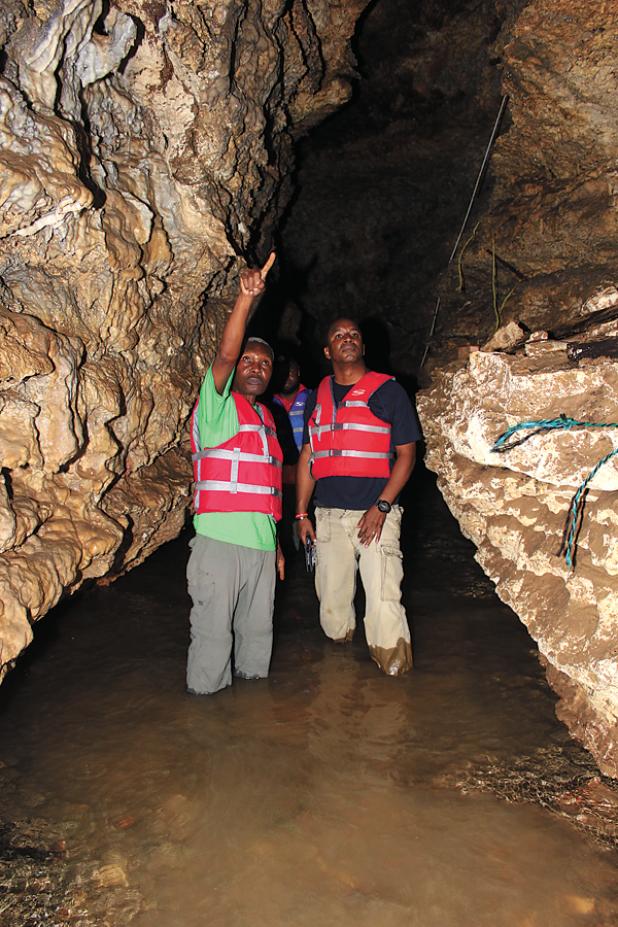
Dr. John Mwansa (left) showing Minister of Energy and Water Resources Wilfred Abrahams the mark where the water levels were back in November.
Levels lowering at Bowmanston
Barbados is in dire need of some rainfall if the island is to steer its way out of the water crisis in which it currently finds itself.
This is the alarming news coming after Minister of Energy and Water Resources Wilfred Abrahams and Barbados Water Authority Technical Advisor Dr. John Mwansa took a trip into the underground cave to take a look at water supply conditions at the Bowmanston Pumping Station.
With a handful of Ministry officials and members of the media taking the trek 269 feet down into the well, those on-hand were met with a rather surprising development. Noting that back in November of 2019 the water level was so high they had to start swimming upon exiting the lift, Dr. Mwansa explained that the levels were a far cry from what they were at the tail end of last year’s rainy season. “Today when we stepped out of the lift, we had to step down a ladder 15 feet to the bottom of the well and that was dry. So when you look at the depth of the water that is in the cave, there is a difference of about 15 to 20 feet between what it was in November last year and what it is now,” he said.
Dr. Mwansa explained that although there was somewhat heavy rainfall the past few days, it takes about 90 days to filter through the coral stone before making it into the aquifers and that would not register in the cave as yet. He also revealed that the underground water system was massive and extensive and that the low levels at Bowmanston had some far-reaching effects.
“The other thing that was noticeable was that the well that we went in, normally you would step into the water and that body of water connects the downstream section, with the upstream section where the pumps are. Because the section that is between is dry that means the upstream section cannot pull water from the downstream section. So the amount of water we can pull from here is reduced until the two water bodies connect back.”
With three pumps normally in operation when the water supply is high, Mwansa explained that the Bowmanston station pumps to two reservoirs at Bowmanston and Golden Ridge, which in turn feed others and therefore service districts such as Sherbourne, Massiah Street, District C, Cherry Grove and Ellerton, which have all been facing water issues, and as far out as St. Joseph and St. Thomas are affected. With an average of 1.5 to 2 million gallons a day pumped from Bowmanston to feed into the system, Mwansa noted that with the situation being as it is, there would be intermittent service, but that tankers would be deployed.
Mwansa explained that as the levels build back up at night, the teams would pump until they went back down and that the length of service depended solely on the demand. Going on to call the situation extremely concerning as we were completely at the mercy of the whims of Mother Nature, he said that things would continue this way unless there was substantial rainfall in the coming weeks. “If we don’t get any rains then this condition here at Bowmanston will persist. But part of what we are trying to do is bring in water from somewhere else to help supplement the supplies in this area. That is why we have started construction of the Vineyard project, which will be bringing water from Vineyard into these areas,” he said, noting that the project included a new pipeline from Vineyard to Bowmanston and a reservoir at Mount Pleasant or Stewart Hill as well as two booster stations. That project is expected to be completed by December.
With the Atlantic Hurricane Season already in swing and Barbados not receiving much rain by the end of June, Mwansa said that he can only hope the predictions bear fruit. “I can only go on the weather predictions and they are such that we are supposed to have a good hurricane season. A good hurricane season means you will have a number of hurricanes coming in and, generally, the peak of the hurricane season is the period during which we get most of our groundwater recharged and that is the months of September to November,” he said. (MP)
